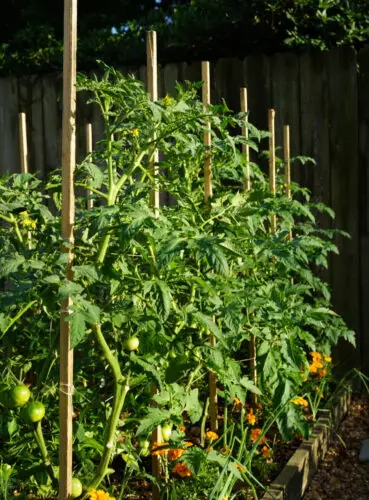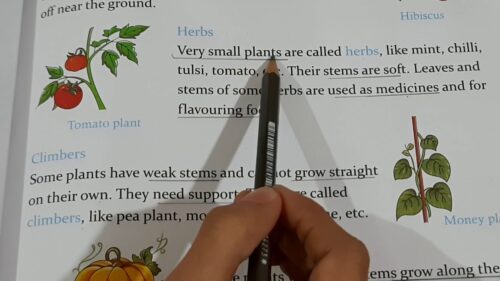Plants need support to develop because some species have weak stems. This is mainly glaring in positive flowering flora and vegetable crops that require additional support as they grow.
Without aid, those flora can also bend, destroy, or come to be pinnacle-heavy, hindering their capacity to reach their most growth ability. Providing aid allows the plants to grow vertically and stops harm from heavy culmination or plants. Additionally, assist structures like trellises, stakes, or cages also sell better air move around the plants, reducing the threat of sicknesses and pests.
By expertise the specific guide desires of various vegetation, gardeners can make certain their healthful and successful boom.
Importance Of Support In Plant Growth
Support is vital for plant life to develop properly, playing a important role in making sure their balance and development. Without right support, some plants may additionally warfare to thrive and attain their full capacity.
Benefits Of Supporting Plants
- Prevents bending or breaking of stems and branches.
- Promotes upright growth for higher exposure to sunlight.
- Enhances air circulate across the plant, lowering the chance of sicknesses.
Types Of Support For Plants
- Stakes
- Trellises
- Cages
- Arbors

Credit: www.Gardenary.Com
Roots Vs Stems: Structural Roles
Plants require various forms of guide to grow and thrive, and this necessity is generally attributed to the structural roles played by means of the roots and stems. Understanding the awesome roles of those essential parts of a plant is crucial in figuring out why some flora want help to grow.
Role Of Roots In Anchoring
The roots of a plant function an anchor, firmly holding the plant in area in the soil. They are answerable for preserving balance and preventing the plant from being uprooted, particularly during damaging weather conditions which includes sturdy winds or heavy rain.
Role Of Stems In Upright Growth
The stems of a plant are on the whole responsible for assisting upright growth. They provide the necessary framework for the plant to reach toward sunlight efficiently, facilitating photosynthesis and allowing the plant to obtain the important nutrients for increase and development.
Factors Influencing Plant Support
Some flowers require support to develop due to factors such as weak stems, heavy culmination, or mountain climbing conduct. Lack of help can cause bending, breaking, or stunted boom in those plants.
Factors Influencing Plant Support Plants frequently require outside help to grow upright, typically stimulated via genetic and environmental factors. Understanding these factors is essential for selling wholesome plant increase and leveraging suitable aid systems. Genetic Factors Genetic predispositions play a vast role in determining a plant’s natural structural integrity. Genetic developments that influence the need for aid consist of stem flexibility, department power, and normal growth habit. Certain species are inherently extra strong and self-assisting, while others may show off traits that require extra assistance to thrive. Environmental Factors Environmental conditions also effect a plant’s want for guide. External elements along with wind depth, soil satisfactory, and mild availability can have an impact on a plant’s balance and boom patterns. Additionally, overcrowding inside a garden or inadequate get admission to to nutrients may additionally result in weaker plant structures, necessitating supplementary help to save you damage or disintegrate. Understanding the interplay of genetic and environmental factors is important for offering the right guide to flowers as they develop and increase. By spotting those affects, gardeners can enforce tailor-made techniques to make sure optimum increase and stability.

Plants That Require Support
Plants that Require Support are regularly people who have specific boom patterns, which necessitate extra structural reinforcement to grow and thrive. Some flowers have particular adaptations that require assist to reach daylight efficiently and keep their balance.
Climbing Plants
Climbing Plants including ivy, clematis, and morning glories develop vertically with the aid of clinging onto structures or using twining stems. Their herbal behavior makes them reliant on outside help to reach extra heights and maximize publicity to mild.
Tall And Top-heavy Plants
Sunflowers, delphiniums, and hollyhocks are examples of Tall and Top-Heavy Plants that require help to prevent them from toppling over as they grow. Their towering stature and heavy blooms necessitate staking or trellising to ensure right increase and balance.
Methods Of Supporting Plants
Plants, similar to human beings, need support to develop and thrive. While some plants have the potential to face on their personal, others require additional assist to save you them from flopping over or breaking below their personal weight. The strategies of assisting vegetation vary, and gardeners have several alternatives to pick from depending on the wishes of their flowers and their preferred aesthetic. Here, we can explore three common methods of supporting plants: trellises and arbors, stakes and supports, and plant tying strategies.
Trellises And Arbors
Trellises and arbors are structures mainly designed to support climbing vegetation including cucumbers, tomatoes, and numerous varieties of vines. These vertical helps not handiest provide a robust framework for the plant life to develop on, but additionally they enhance the overall look of the lawn. Trellises are usually manufactured from a framework of wooden or metallic bars or wires arranged in a grid-like sample. On the other hand, arbors encompass a series of interconnected arches, forming an entrance or a tunnel-like shape.
Plants are skilled to develop upwards along the trellises or arbors, allowing them to take benefit of vertical area and sunlight. This approach not most effective promotes better air circulation around the plant life however additionally helps prevent sicknesses by means of decreasing touch with the soil. As the flora develop and adhere to the assisting structure, the trellises and arbors create a stunning show of foliage and flora, making any lawn sense like a lush, natural paradise.
Stakes And Supports
Stakes and helps are widely used for plants that have susceptible stems or heavy fruiting bodies, which might be at risk of leaning or bending under their personal weight. These plant props are generally inserted into the ground close to the base of the plant, presenting stability and stopping the plant from toppling over. Stakes can be crafted from bamboo, metallic, or other robust substances, while supports can take the form of cages or grids made from wire or netting.
By securing the plant to the stake or help, gardeners make certain that it grows upright and decreases the hazard of bodily harm. It additionally allows airflow and daylight exposure at some stage in the whole plant, minimizing the probabilities of fungal diseases. Staked vegetation are not best less difficult to harvest but also create an appealing visible impact within the garden, in particular while well arranged in rows or styles.
Plant Tying Techniques
Plant tying strategies involve attaching the plant life to their help systems using various tying materials. This approach is useful for plant life with sensitive stems or those who require particular positioning for greatest boom. Common tying materials include lawn cord, plant clips, tender fabric strips, or maybe vintage pantyhose.
When tying flora, it is critical to use substances which might be gentle enough now not to harm the stems however strong sufficient to keep them securely in place. Gardeners can employ different tying techniques along with the parent-8 loop, the slipknot, or the twist and tuck technique, relying at the wishes and traits of the plant. These strategies permit for flexibility and adjustability because the plant grows, making sure that it remains nicely-supported during its life cycle.

Credit: treleaf.Keep
Frequently Asked Questions On Why Do Some Plants Need Support To Grow?
Why Do Some Plant Need A Support?
Plants need assist to develop upright, preserve proper posture, and save you bending or breaking under the load of leaves or flora.
What Plants Need Supports?
Plants consisting of tomatoes, cucumbers, and peas need helps to help them develop upright and save you bending or breaking. Providing helps ensures wholesome, productive vegetation in your lawn.
Do Plants Grow Better With Support?
Yes, flowers develop higher with guide because it enables them to face upright and promotes wholesome boom. Providing assist also prevents damage to the stems and guarantees that the plants acquire right sunlight and air move.
Why Do Plants Need To Grow?
Plants need to develop for photosynthesis, to supply oxygen, meals for animals, and to support ecosystems.
Conclusion
Plants wanting guide to grow is not unusual. Understanding their requirements facilitates nurture wholesome increase. Providing assist allows flowers to reach full capability. Consider factors like weight, structure, and growth behavior. Supporting flora guarantees balance as they increase and thrive naturally.
Invest in the proper support systems for finest plant care.
